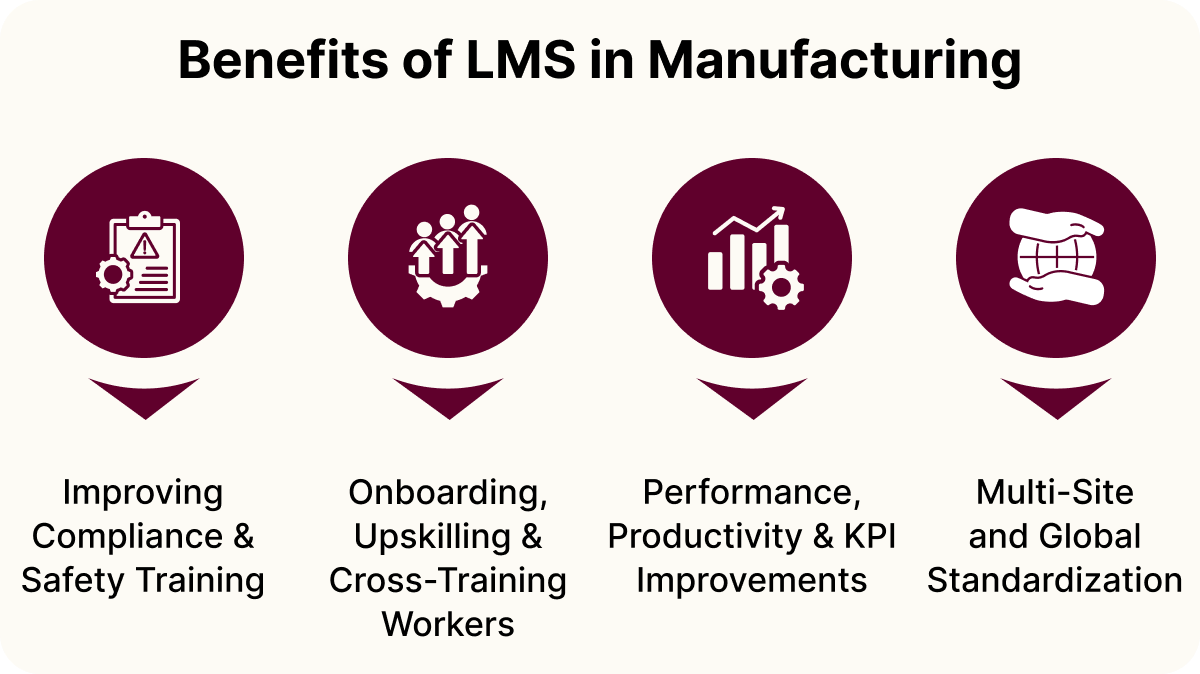How Manufacturing Companies Use LMS to Reduce Downtime and Increase Productivity

Ongoing learning and staff skill refinement are integral to any manufacturing business’s success and sustainable operations. That’s why manufacturing companies use a learning management system for manufacturing to streamline compliance, improve worker safety, and increase productivity. By adopting modern LMS solutions, they can deliver consistent training across plants, reduce operational risks, and equip employees with the right skills faster than traditional methods. This approach ensures knowledge is available on demand, helping companies stay competitive in a fast-changing industry.
Read on to get a detailed breakdown of manufacturing LMS benefits, features your LMS should include to deliver real value, and the practicalities of its implementation.
Benefits of LMS in Manufacturing
In the broadest sense, manufacturers implement manufacturing LMS platforms to solve critical training challenges and standardize workforce development. These systems directly support compliance, safety, onboarding, and performance improvement, delivering measurable business outcomes. Here are some practical advantages you’re sure to reap for your manufacturing business.

Improving Compliance and Safety Training
Compliance and safety are the most immediate benefits of an LMS for manufacturing companies. A functional, manufacturing-specific LMS ensures that:
- Training modules can be updated quickly to reflect new regulations.
- Certification tracking guarantees employees have up-to-date credentials.
- Audit readiness improves because all training data is centralized and easily retrievable.
This way, by digitizing training records and automating certifications, companies ensure workers meet OSHA and ISO standards with less administrative burden.
Onboarding, Upskilling & Cross-Training Workers
Another major benefit is faster and more effective onboarding. A learning management system for manufacturing allows new hires to complete safety, quality, and compliance modules before they begin working on the production floor. This reduces downtime and ensures consistent skill levels across shifts.
Key use cases include:
- Onboarding programs. Employees complete essential safety and quality courses before active duty.
- Cross-training. Workers can be qualified for multiple roles, reducing your dependency on specific personnel.
- Upskilling paths. Advanced modules allow operators to move into supervisory positions, supporting career growth.
Performance, Productivity & KPI Improvements
A manufacturing LMS doesn’t just deliver training — it measures its impact. Advanced platforms track worker performance, productivity metrics, and error reduction linked directly to training initiatives.
For instance:
- Training tied to machine operation can lower defect rates by 10–15%.
- Just-in-time learning reduces downtime when troubleshooting equipment.
- Certification tracking ensures only qualified staff operate high-risk machinery.
For these reasons, companies that integrate learning analytics with production data often see measurable ROI.
Multi-Site and Global Standardization
The ability to maintain one global standard improves product quality and reduces variability across sites. To achieve a high level of harmonization, manufacturers with multiple facilities must ensure consistency across operations. A learning management system for manufacturing provides a unified training environment that standardizes procedures across plants, geographies, and even languages. Such systems’ common standardization features include:
- Multi-site rollouts where every plant follows the same training protocols.
- Localization features for delivering training in multiple languages.
- Centralized dashboards for global HR and compliance teams.
Core Benefits of LMS in Manufacturing
Key Features & Functional Requirements of LMS for Manufacturing
A Learning Management System for manufacturing must provide functionality that meets the unique needs of industrial environments, from compliance tracking to integration with factory systems. Unlike general-purpose tools, a manufacturing LMS is designed to support frontline workers, plant managers, and global compliance officers. Here are the main features to look for when choosing an LMS applicable in the manufacturing industry.

Offline and Mobile Access
Manufacturing plants often operate in environments with limited or inconsistent connectivity. A strong manufacturing LMS must support offline training, allowing employees to download modules to mobile devices and sync results once connected. Mobile compatibility ensures training can be completed on the shop floor using tablets or ruggedized handheld devices.
Integration with ERP, HRIS, MES, and SCADA
Seamless integration is one of the top requirements for a learning management system for manufacturing companies. An LMS that connects with ERP (SAP, Oracle), HRIS (Workday), or MES/SCADA systems allows training data to align with production schedules and workforce records.
This integration enables:
- Automatic assignment of training based on job roles from HRIS.
- Linking LMS performance data with ERP productivity metrics.
- Synchronization with MES to ensure only trained employees operate machines.
Support for Hands-On Training and Simulation
Top manufacturing LMS platforms extend beyond digital courses. They incorporate simulation, AR/VR, and interactive modules to replicate real-world machine operations. Such an introduction of hands-on training reduces risks, as employees can practice procedures virtually before handling live equipment.
Examples of applications fostering practical training include:
- AR glasses for assembly line training.
- VR simulations for hazardous material handling.
- Digital twins for machine troubleshooting exercises.
Compliance and Certification Tracking
Beyond technical features, manufacturing LMSs should enable compliance training. Regulatory oversight is central to manufacturing. An LMS for manufacturing companies should automate compliance by issuing certificates, setting renewal reminders, and generating audit-ready reports. This element ensures workers remain qualified and reduces administrative workload for training managers.
Key functions of a top-tier LMS suited for manufacturing business goals include:
- Automated recertification. Tracks expiration dates and assigns courses proactively.
- Regulatory alignment. Supports OSHA, ISO 9001, and sector-specific standards.
- Audit trail reports. Centralized documentation for inspectors and auditors.
Learner Analytics, Skills Gap Analysis, and Adaptive Learning
An advanced manufacturing LMS doesn’t just deliver courses — it provides analytics that help organizations identify skill shortages. By comparing worker competencies against production requirements, companies can prioritize training for high-impact areas. Analytical functions that an investment-worthy LMS should incorporate are as follows:
- Skills gap analysis. Identifies where workers need additional training.
- Adaptive learning paths. Adjusts content based on employee performance.
- Predictive analytics. Forecasts future training needs based on production trends.
Multi-Tenant & Extended Enterprise Training
Manufacturing rarely operates in isolation. Besides setting up their internal processes, companies must also train distributors, suppliers, and contractors. Multi-tenant architecture in an LMS for manufacturing companies aids these goals by enabling organizations to create separate branded portals for each group while maintaining centralized control.
Benefits of multi-tenant LMS functionality include:
- Partner training to ensure product knowledge consistency.
- Supplier compliance programs for quality assurance.
- Customer education portals to reduce support requests.
Must-Have Features of Manufacturing LMS
Implementation, Adoption & Change Management
Choosing a high-quality, feature-rich LMS is not a guarantee of your success. Successful deployment of a Learning Management System for manufacturing requires planning, stakeholder support, and user adoption. The most effective rollouts start small, prove value, and then scale across shifts and sites without disrupting production.
Key implementation success factors you should keep in mind include:
- Phased rollout. Pilot programs reduce risks and allow quick adjustments.
- Stakeholder alignment. HR, plant managers, and safety officers must share ownership.
- Content strategy. Legacy materials should be converted into modern digital modules.
- Frontline support. Mobile-friendly design, microlearning, and multilingual options drive adoption.
- Change management. Clear communication, incentives, and usage tracking help overcome resistance.
When companies align governance with worker needs and provide accessible training, a manufacturing LMS delivers faster adoption and long-term impact.
Conclusion
LMSs become more commonplace in all industrial sectors, proving their efficiency and relevance to a wide range of sectoral needs, including manufacturing. This article’s insights prove that a learning management system for manufacturing enables companies to train their workforce more effectively, ensure compliance, and standardize processes across multiple sites. By supporting mobile and offline access, integration with ERP and MES systems, and advanced features like simulation and analytics, an LMS addresses the unique challenges of industrial environments.
When implemented with clear rollout strategies and strong stakeholder alignment, your manufacturing LMS is sure to improve safety, reduce downtime, and help close contingent skill gaps.
That’s why for manufacturers seeking to boost productivity while maintaining strict compliance, investing in the right LMS is no longer optional. It is a critical step toward long-term competitiveness and growth.
Frequently Asked Questions






